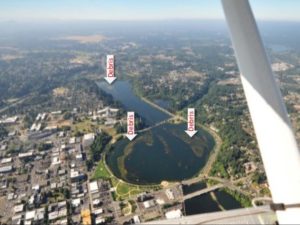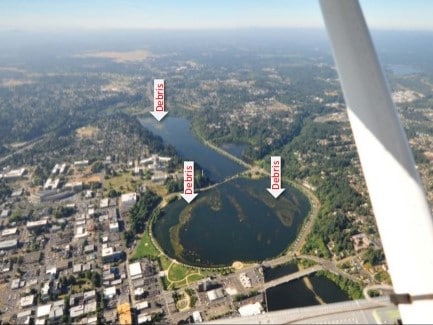Why a Deschutes River Clean-Up Plan?

(Algae scum on Capitol Lake below Deschutes River, Ecology photo 2015)
NWEA has challenged the U.S. Environmental Protection Agency’s (EPA) unlawful stalling of Washington’s Deschutes River clean-up plan. NWEA filed the lawsuit because EPA has failed for nearly two years to approve or disapprove the Deschutes Total Maximum Daily Load (TMDL) clean-up plan even though the Clean Water Act requires EPA to act within 30 days of a state’s submission. The Washington Department of Ecology submitted the TMDL to EPA for approval nearly two years ago, in December 2015.
The Deschutes River is a tributary to Puget Sound, discharging to Capitol Lake and then the marine waters of Budd Inlet in Olympia. Rivers and streams in the Deschutes watershed violate state water quality standards for temperature, dissolved oxygen, pH, fine sediment, fecal coliform, and bacteria. Budd Inlet has suffered for decades from low levels of dissolved oxygen and Capitol Lake is filled with algae from nutrient pollution.
A Tortured History
The Deschutes TMDL had a long and tortured history before it ended up sitting on EPA’s desk for almost two years without action. Ecology began working on the plan in 2002. Then it took another 13 years for Ecology to complete the plan and submit it to EPA for approval in 2015. This summer, Ecology asked EPA to act swiftly on some parts of the Deschutes TMDL, but it was silent on what EPA should do about waters affected by unsafe levels of dissolved oxygen. Pollution causing problems with dissolved oxygen is likely why EPA has failed to approve the plan.
Although the draft Deschutes TMDL included the marine waters of Budd Inlet, when Ecology submitted the final version to EPA, it carved Budd Inlet out of the analysis. Ecology pointed to its inability to account for nitrogen pollution coming into Budd Inlet from sewage treatment plants throughout Puget Sound that are contributing to dissolved oxygen problems. But at the same time, Ecology has been stalling on developing a TMDL for nitrogen in Puget Sound that would also allow it to complete the TMDL for Budd Inlet. Ecology’s refusal to follow the law was the basis of NWEA’s petitioning Ecology for rulemaking in October 2017. In its petition to Ecology, NWEA pointed out that the agency has been playing games rather than developing a TMDL for nitrogen in all of Puget Sound.
Agency Failure
The lack of EPA action on the Deschutes TMDL reflects the failures of both EPA and Ecology. Both agencies are well aware that the Deschutes is connected to the larger pollution problems of Puget Sound but neither agency wants to tackle the political hot potato of developing a Puget Sound TMDL that will require the installation of pollution controls on sewage treatment plants. So EPA just sits on its hands.
Bryan Telegin of Bricklin & Newman LLP (Seattle) and Lia Comerford of the Earthrise Law Center at Lewis & Clark Law School (Portland) represent NWEA in this case.

